
|

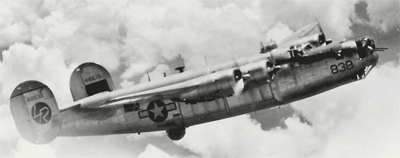
This picture is the same B-24 model and look as the Coleman plane. B-24J's of the 307th Bomb Group with the Long Ranger's group marking on the fin, LR in white on an insignia blue disc, and the upper, outer tail tips painted in the squadron color.
|
The Coleman Crew's B-24J (AAF Serial #44-40598) departed Mokerang Field, Los Negros (Bismarck Archipalago) the morning of June 25, 1944 with the ten crew members listed below. After dropping bombs on the airfield of the Japanese held island, the plane was attacked by a Japanese fighter and crashed 3-5 miles southeast of the southern tip of Yap Island.
According to records, the Coleman B-24J was delivered to the USAAF on 25 April 1944. It went to the Fourth Air Force Provisional Unit, Hamiliton AAF, CA on 7 May 1944 and departed the US on 22 May 1944 for assignment with the Thirteenth Air Force, China-Burma-India Theater of Operations. It was dropped from inventory as a combat loss on 30 June 1944.
PAT NOTE: Out of all the 18,000+ B-24's produced during WWII, only two are still flying. I was able to see both planes during the month of July 2005 and took the following pictures.
Pat Note: Thus far I can only locate 7 mission reports involving the Coleman crew starting on 23 April 1944 and ended with the 25 June 1944 shoot down. The Coleman crew flew a number of different planes including #863, #372, and #598. View Coleman Crew mission reports
History: Life for the B-24 heavy bomber began in 1939, when the U.S. Army Air Corps initiated a request for a new bomber designed to exceed the performance of the B-17. Consolidated Aircraft responded quickly with its proposal, labeled Consolidated Model 32 and, on March 30 of 1939, was awarded the contract. One day short of nine months later, on December 29, 1939, the first flight of the XB-24 bomber prototype took place.
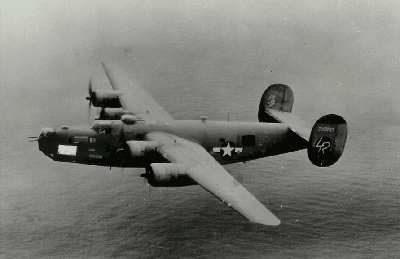 Slightly smaller than the B-17, the turbosupercharger-equipped B-24 flew farther with a bigger bomb load than the much more publicized Boeing aircraft. Of seven service-test YB-24s, six were sent to the Royal Air Force (RAF) under the export designation LB-30A. Because they lacked turbosuperchargers and self-sealing fuel tanks, the RAF found them unsuitable for combat duty over Europe. Instead, they were stripped of their armament and put into service as transports on the Trans-Atlantic Return Ferry Service, which had been established to send air crews to Montreal to take delivery of American aircraft consigned to the British war effort.
Slightly smaller than the B-17, the turbosupercharger-equipped B-24 flew farther with a bigger bomb load than the much more publicized Boeing aircraft. Of seven service-test YB-24s, six were sent to the Royal Air Force (RAF) under the export designation LB-30A. Because they lacked turbosuperchargers and self-sealing fuel tanks, the RAF found them unsuitable for combat duty over Europe. Instead, they were stripped of their armament and put into service as transports on the Trans-Atlantic Return Ferry Service, which had been established to send air crews to Montreal to take delivery of American aircraft consigned to the British war effort.
Flying for the Army Air Corps as the B-24, and the U.S. Navy as the PB4Y-1, the plane also saw service in the Royal Air Force where it was known simply as the Liberator. There was also a transport version known as the C-87, one of which was Winston Churchill's personal aircraft, carrying him to historic meetings at Moscow and Casablanca, among other locations.
Before the last one was retired from Air Force service in 1953, the plane was produced in variations ranging through type M. The various model numbers were often the result of minor changes, like the relocation of internal equipment, but one major revision, the conversion of the standard Navy B-24 (PB4Y-1) to the PB4Y-2 Privateer, involved a significant rework that exchanged the familiar twin tail for a single tall tail fin and rudder combination. It also had a stretched forward fuselage that placed the pilot's compartment well in front of the un-turbocharged Pratt & Whitney R1830-94 Twin Wasp engines.
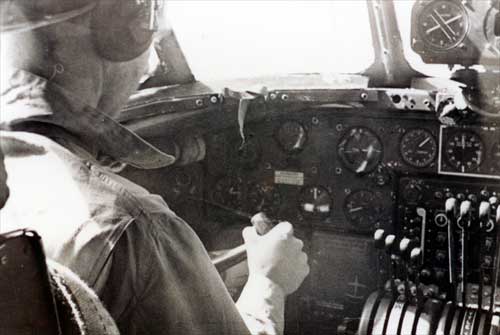 Among the features that distinguished the B-24 from the B-17 were its tricycle landing gear (the first installed in a heavy operational aircraft), the mid-mounted, high-lift Davis wing that achieved 20 percent less drag than conventional airfoils of the time, twin tail fins, oval-shaped engine cowlings necessitated by the mounting of turbosuperchargers, unique roll-up bomb bay doors that reduced drag considerably when open, and a fully retractable ventral machine gun turret. The B-24 was also the first to employ Hamilton hydromatic quick-feathering three-blade propellers.
Among the features that distinguished the B-24 from the B-17 were its tricycle landing gear (the first installed in a heavy operational aircraft), the mid-mounted, high-lift Davis wing that achieved 20 percent less drag than conventional airfoils of the time, twin tail fins, oval-shaped engine cowlings necessitated by the mounting of turbosuperchargers, unique roll-up bomb bay doors that reduced drag considerably when open, and a fully retractable ventral machine gun turret. The B-24 was also the first to employ Hamilton hydromatic quick-feathering three-blade propellers.
While designed as a heavy bomber, the B-24 experienced more than 100 modifications and conversions for such assignments as photography, mine laying, and cargo hauling (including a C-109 fuel tanker version that flew "the Hump" to refuel B-29s operating out of forward bases in China). More than 18,000 B-24s were built during WWII, more than any other American aircraft. Given its abilities and "convert-abilities," the numbers make perfect sense. However, a postwar attempt to combine portions of the B-24 and PB4Y-2 with a new fuselage to create the Convair Model 39 airliner was not a commercial success, with only one prototype being built.
Of the many thousands of B-24s and derivatives built, only three remain airworthy, all in the United States. [History by Kevin Murphy]
 Nicknames: Lib; Ford's Folly; Flying Boxcar; Liberator Express (C-87 variant); C-One-Oh-Boom (C-109 fuel-carrying variant); Lamp Lighter (PB4Y-2s dropping parachute flares in Korea).
Nicknames: Lib; Ford's Folly; Flying Boxcar; Liberator Express (C-87 variant); C-One-Oh-Boom (C-109 fuel-carrying variant); Lamp Lighter (PB4Y-2s dropping parachute flares in Korea).
Specifications (B-24H/J):
- Engines: Four 1,200-hp Pratt & Whitney R-1830-65 Twin Wasp turbocharged radial piston engines.
-
Weight: Empty 36,500 lbs., Max Overload Takeoff 71,200 lbs.
-
Wing Span: 110ft. 0in.v
Length: 67ft. 2in.
-
Height: 18ft. 0in.
-
Performance:
- Maximum Speed at 25,000 ft: 290 mph
-
Cruising Speed: 215 mph
-
Ceiling: 28,000 ft.
-
Range: 2,100 miles
-
Armament:
-
10 12.7-mm (0.5-inch) machine guns in nose, upper/ventral ball turrets and tail turret, and lateral fuselage positions.
-
12,800 lb. maximum bomb load.
Number Built: 18,000+
Number Still Airworthy: Three (Two B-24Js and one LB-30)
| Excerpt from "A Missing Plane" by Susan Sheehan: |
|
Pat's Note: The following excerpt from "A Missing Plane" provides some interesting comments about the B-24.
In 1969 David Becker, a pilot who had flown a B-24 across the Pacific the same week as Bob Allred, wrote a letter in the form of a memoir to this son. Becker, a jeweler in Terre Haute, was then nearing the age of fifty. "Looking back, I cannot say that to me my life has been dull, but I must admit that it has been quite routine and undistinguished," he wrote. "However, there was one four-year period in my life that was neither routine or uneventful. Those were the years that I spent in the service in World War II during 1942, 1943, 1944, and 1945."
It was those four years that Becker dwelt on in his letter-memoir. He recalled that he got his first glimpse of a B-24 in the spring of 1943, at an airfield near Houston where he was taking Multi-Engine Advanced Training. He wrote:
Honest to God, it was the biggest damn plane I had ever seen. The lieutenant who had flown it in said we could enter through the forward bomb bay, walk along the catwalk, go through the hatch, get up into the flight deck, and look around. I had never seen so many instruments, dials, radios, knobs, and buttons in my life. I was sure then that I wanted to fly a B-24, but I remember thinking, How in the devil could a guy learn to fly a monster like that? Don't forget, at the time it was the biggest bomber in the United States. The B-29, out first super-bomber, was only being tested in early '43. The B-24D was 66 feet 4 inches long and had a wingspan of 110 feet. It had four Pratt & Whitney 1,200 horsepower engines. The propaganda put out about it said it would fly easily at 25,000 feet, carry a bomb load of 8.900 pounds, go 2,850 miles without refueling, and travel at a maximum speed of 300 miles per hour. Several months later, when I started flying B-24s, I learned that some of those numbers were misleading. The plane went up to 25,000 feet if its engines were new and it carried a minimum crew and a minimum amount of gas, but in training I was flying ancient clunkers and the highest I ever got in one was 19,000 feet and so help me we couldn't have gone an inch higher if I had thrown out crew to lighten the ship. It would carry four tons of bombs if it carried a minimum of gas. It would fly 2,850 miles without refueling if it carried no bombs (for long flights extra gas tanks were installed in the forward bomb bay), and it would go 300 miles per hour if you put the nose straight down in a full power dive. But all in all it was one helluva airplane for its time.
|
Return to top
| Diagram showing B-24 Emergency Equipment and Escape Exits: |
|
The folowing excerpt from the book, "Devil at My Heels: A WW II Hero's Epic Saga of Torment, Survival, and Forgiveness " by Louis Zamperini explains how the lift rafts would have come out of the plane when it hit the water: "All B-24s pack two life rafts in fuselage compartments above the wings, mounted against spring-loaded plates. The outside covers latch with a pin, with a weight on the end. When the plane hits water, the impact dislodges the pin, the doors burst open, and the spring plate throws the rafts out about a hundred fet, over each wing, into the ocean. That pulls a trigger mechanism and the rafts inflate while still attached to the plane by parachute cord. When the plane sinks below a certain depth, the cords pull free of the plane."
Click to enlarge the following images showing B-24 emergency equipment and escape exits:
Please submit additional information.
|
Return to top
| Links to other B-24 related web sites: |
|
|
Return to top
Submit comments about this site
Web Site Terms of Use: This web site authorizes you to view materials solely for your personal, non-commercial use. You may not sell or modify the material or reproduce, display, distribute, or otherwise use the material in any way for any public or commercial purpose without the written permission of the web site owner. pat@missingaircrew.com
|

|





 Slightly smaller than the B-17, the turbosupercharger-equipped B-24 flew farther with a bigger bomb load than the much more publicized Boeing aircraft. Of seven service-test YB-24s, six were sent to the Royal Air Force (RAF) under the export designation LB-30A. Because they lacked turbosuperchargers and self-sealing fuel tanks, the RAF found them unsuitable for combat duty over Europe. Instead, they were stripped of their armament and put into service as transports on the Trans-Atlantic Return Ferry Service, which had been established to send air crews to Montreal to take delivery of American aircraft consigned to the British war effort.
Slightly smaller than the B-17, the turbosupercharger-equipped B-24 flew farther with a bigger bomb load than the much more publicized Boeing aircraft. Of seven service-test YB-24s, six were sent to the Royal Air Force (RAF) under the export designation LB-30A. Because they lacked turbosuperchargers and self-sealing fuel tanks, the RAF found them unsuitable for combat duty over Europe. Instead, they were stripped of their armament and put into service as transports on the Trans-Atlantic Return Ferry Service, which had been established to send air crews to Montreal to take delivery of American aircraft consigned to the British war effort.
 Among the features that distinguished the B-24 from the B-17 were its tricycle landing gear (the first installed in a heavy operational aircraft), the mid-mounted, high-lift Davis wing that achieved 20 percent less drag than conventional airfoils of the time, twin tail fins, oval-shaped engine cowlings necessitated by the mounting of turbosuperchargers, unique roll-up bomb bay doors that reduced drag considerably when open, and a fully retractable ventral machine gun turret. The B-24 was also the first to employ Hamilton hydromatic quick-feathering three-blade propellers.
Among the features that distinguished the B-24 from the B-17 were its tricycle landing gear (the first installed in a heavy operational aircraft), the mid-mounted, high-lift Davis wing that achieved 20 percent less drag than conventional airfoils of the time, twin tail fins, oval-shaped engine cowlings necessitated by the mounting of turbosuperchargers, unique roll-up bomb bay doors that reduced drag considerably when open, and a fully retractable ventral machine gun turret. The B-24 was also the first to employ Hamilton hydromatic quick-feathering three-blade propellers.
 Nicknames: Lib; Ford's Folly; Flying Boxcar; Liberator Express (C-87 variant); C-One-Oh-Boom (C-109 fuel-carrying variant); Lamp Lighter (PB4Y-2s dropping parachute flares in Korea).
Nicknames: Lib; Ford's Folly; Flying Boxcar; Liberator Express (C-87 variant); C-One-Oh-Boom (C-109 fuel-carrying variant); Lamp Lighter (PB4Y-2s dropping parachute flares in Korea).
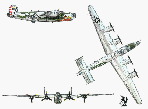
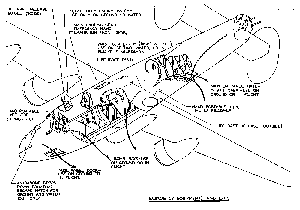




 PIN IT
PIN IT